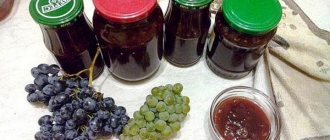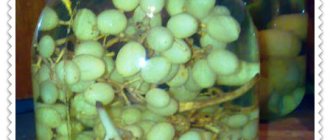Features of growing grapes from seed
A vineyard is created by cuttings or seedlings. There are many problems with grains, and therefore this option is rarely used in gardening. When planting seeds, you need to prepare for unforeseen situations. It is difficult to determine exactly what indicators a seedling will take. The fruits may not appear large or juicy as desired.
Planting from grains is justified in three cases:
- Desire to get a new look.
- The variety requires a rootstock - you can graft a cutting onto the plant, which will bring an excellent harvest.
- Interest in the growing process itself.
Do you dream of testing yourself as a breeder? Plant a couple of grains of the same variety and compare the growing bushes. Continue caring for the most resilient and strong plant.
If you create good conditions from the seed during cultivation and ensure normal temperature conditions, then after two weeks you can get ready-made sprouts.
Mandatory conditions for growing a plant from seed:
- Water the seedling with water at room temperature.
- The soil needs to be loosened, this must be done carefully so that the roots are not damaged.
- Use a variety of fertilizers as needed.
- If you grow a plant on the sunny side, shade the grapes a little. If there are drafts, remove the plant to another place.
- Bushes are affected by diseases and insects. In the spring, transplant the seedlings into larger containers.
As soon as the seedlings reach a certain height, become stronger and more frost-resistant, the grapes are moved to open soil. The breeder should pay special attention to pre-hardening. Thanks to this method, the grapes will take root better.
How justified is it to grow grapes from seeds?
The “home” vine differs from the “street” vine in various ways. It is more pleasant, the berries are tender and juicy. It begins to bear fruit five years after planting in the ground. The first harvest is small, the fruits have a predominantly sourish, weakly expressed taste. Every year the berries become juicier.
There is a risk of poor growth of seedlings from seeds. With improper care, errors during care and replanting, the grapes can grow weak and unproductive.
Is it possible to grow grapes from seeds at home?
Although numerous studies confirm that the method of propagating grapes with seeds is not always justified. This is due to the fact that the seedling rarely retains the varietal properties of the parent plant. But this method is sometimes used
Goals of growing grapes from seed
- Breeding work (breeding hybrids, developing varieties with the best taste, resistant to frost and disease).
- Cultivation of seedlings.
- Decorative use of seedlings.
- Growing a rootstock.
Not all grape varieties are suitable for propagation by seeds; early hybrid varieties are often used:
- Russian Concord,
- Marshmallow,
- Delight,
- Kesha-1,
- Triumph,
- Laura.
And the productive qualities of self-fertile varieties: Early Zorka, Alpha, Russian Violet are inferior to the mother bushes. The choice depends on the purpose of using the berries: sour ones are for winemaking, sweet ones are eaten without processing.
Bunches of Russian Concord grapes
Delight grapes, suitable for growing from seed
Zephyr grape variety
Kesha-1, grown from seeds
Lora variety
Blue grapes triumph
Species characteristics are not always preserved. Therefore, you can sow several seeds of the same variety at once. In the future, compare taste, yield, resistance to pests and frost.
Grapes grown from seed are significantly inferior in yield and taste of fruits compared to plants propagated by layering or cuttings.
Which variety is suitable for growing?
It is necessary to decide on its use in the future. Grapes can serve as the basis for creating homemade wine, jam, and compotes. The berries can be eaten fresh, sold, or used as a decoration for dishes. For these cases, a specific plant variety is chosen.
- For preservation – the Isabella variety.
- For trade, decoration or consumption - Tamerlane or Talisman.
- For wine – Chardonnay, Bianca, Saperavi or Regent.
You can finally choose a variety after determining how quickly the grapes will develop in your region, climate, and soil. If you create good conditions for the bushes and grow them in a suitable area, the result will not be long in coming.
Suitable varieties
To choose the optimal variety, first of all, it is worth determining the scope of application of the berries. The fruits can be used to make jam, compotes, and wine. They can be consumed fresh or sold. Berries are often used to decorate dishes. Depending on the purpose of the fruit, the variety is chosen.
The climatic features of the region are of no small importance. Also, when choosing a variety, it is worth considering the composition of the soil. If you create normal conditions for the plant and grow it in the right area, you will be able to get good results.
When choosing a variety for cultivation, gardeners take into account yield parameters. The most productive plants include the following:
- Wax;
- Northern;
- Laura;
- Victor;
- Mascot;
- Codrianka.
It is recommended to take seed material from new early varieties. It is also permissible to use hybrids that bear fruit in local conditions. Such crops are considered more preferable, since breeders have already managed to work on the variety. Thanks to this, it has become more resistant to frost and other climatic conditions.
When choosing a hybrid, you should definitely consider its origin. European varieties are characterized by low germination. Amur and American varieties are superior to them in this parameter.
It is best to use grape seeds that are grown in the same area. Fruits brought from the southern regions will bear worse fruit in central Russia.
Grapes grown by seed usually produce a harvest only 4-5 years after planting. At the same time, there are varieties that are capable of bearing fruit the following year. It is important to consider that such berries most likely cannot be eaten or used to make wine.
See also
Description of the Bazhena grape variety, planting and care rules
Read
For preservation
For preparations, it is permissible to use varieties that have dense and aromatic fruits. According to many housewives, Isabella grapes are considered the best option.
For trade
It is worth growing varieties for sale that are easy to transport and have excellent commercial qualities. These include Talisman or Tamerlane grapes.
For decoration
For decorative purposes, varieties are used whose fruits are large in size and beautiful in shape. For this purpose, it is permissible to use varieties Tamerlan and Talisman.
For food
Berries that have a sweet taste and contain few seeds are well suited for fresh consumption. Good options would be the varieties Tamerlan and Talisman.
For wine
For winemaking, special varieties are used that have a pronounced aroma. Good options would be Bianca, Regent. Saperavi or Chardonnay varieties are also often chosen.
How to make sure the seeds are viable?
After choosing a variety, you need to start removing the seeds from the fruit. You can buy seeds from special agricultural companies or get them yourself.
Watch a video about germinating grape seeds:
Stages of seed selection:
- Make sure the grains are suitable. Healthy planting material is hard to the touch.
- Carefully inspect the bone, its shade is especially important. A suitable seed has a white liquid under the shell.
- Place the material in water. All unripe seeds will float, healthy ones will drown.
Germinating grape seeds: preparation
Before planting grape seeds, they need to be stratified. This technique increases germination and boils down to keeping the seeds for 2–4 months at a temperature of +1…+5 °C. They are placed in a cotton bag or laid out on damp thin foam rubber and rolled up, put into plastic bags with tags and stored in the refrigerator on the bottom shelf. Occasionally the seeds should be removed and washed. To prevent mold from forming, they can be placed in a saucer with 3% hydrogen peroxide for 10 minutes. Then spread on a thick paper napkin soaked in hydrogen peroxide, fold and place in a plastic bag in the refrigerator. Cracking of the seeds is a signal of readiness for germination. They are placed on a napkin moistened with water (preferably melted water or spring water) and moved to a warm place until roots appear.
stages of grape development when grown from seeds
Stratification of grape seeds can be carried out in another way: mix them with calcined and moistened sand in a 1:2 ratio in a clay pot and bury it until spring to a depth of 40 cm in a dry place on the site.
Preparing to plant grapes from seeds
After completely checking the seeds for viability, they need to be washed.
Planting grains are filled with water and left for a day. After the bones are stratified, this procedure is called stratification.
Germination of grains can be stopped or accelerated. If you plan to grow the bush after a month or more, you can place the seeds in a cold and damp place. A suitable environment for slowing development is being in the soil in winter. But to grow seeds at home, the germination process should be accelerated.
Substrate
Substrate - airtight packaging with plenty of damp paper towels. In addition to towels, you can use sand and peat moss. It is better to leave your choice on the last option, since moss has antifungal characteristics and quickly gets rid of mold.
Plastic bag
The bones are placed in a bag, distributing them over the area. A special earthen mixture is poured on top of the grains, the thickness of which should not be more than 15 mm. The package must be placed in a damp and cool place. The best option is a refrigerator. Storage period – 90 days.
You cannot put the package in the freezer, only on the shelf. Grains for planting are taken out in early March, and the grains are planted in containers. It is important to plant the seeds one at a time in each pot.
Temperature
The nighttime reading cannot drop below 15 degrees. To prevent the temperature from dropping or rising, the seeds should be stored in a greenhouse or using heating mats.
The soil
You cannot fill the soil if you have recently watered the plant, but the soil is already dry - use a sprayer. Sprouts break through the soil layer from 14 to 56 days. Carry out regular monitoring of plant development.
You can replant the bushes only when they reach 8 cm in height. In order for the plant to become strong and frost-resistant, the pots should not be taken out into the garden until the grapes reach 30 cm. In addition, the roots of the plants should become stronger and about 6 leaves should appear on the stems.
Variety selection
To propagate grapes by seeds, you must first select a suitable variety. It is better to give preference to hybrid varieties that were bred by crossing 2-3 varieties that are distinguished by high quality fruits and resistance to diseases characteristic of this crop.
Learn how to plant grapes in a greenhouse.
Options suitable for seed propagation:
- Mascot;
- Victoria;
- Chaush;
- Delight;
- Russian Concorde.
Rules and stages of cultivation
Growing rules - fulfillment of all planting and care requirements.
Landing
Preference should be given to fertile soil; you can do it yourself. Fertile soil is a substance made up of equal parts of humus and sand. Fill the container with the substance, incubate the grains to a depth of 1 cm. The containers are placed close to the window, the seedlings need light.
The appearance of sprouts
Externally, the seedlings resemble pepper seedlings. They need care, watering, loosening the soil. It is necessary to apply the optimal amount of fertilizing and organize work to combat harmful insects. The main enemy of grapes is spider mites.
Transplantation
At the end of May, young shoots are transferred to convenient wide containers, and the pots are taken to the loggia. Over the summer period, the grapevine can reach a couple of meters in height. With the onset of the autumn season, the bushes are planted in the garden. Plants can be transplanted immediately, but hardening must be carried out before doing this. To do this, take the pot with the bush outside for half an hour, then for an hour, two, etc.
Sowing in a pot at home
Sowing stages
- Prepare the soil. For these purposes, use store-bought or mix sand, humus and garden soil yourself in equal proportions.
- It is advisable to use a separate container for each seedling. First, a drainage hole is made in each and several pebbles are poured onto the bottom. Fill with earthen mixture.
- The seed should be planted to a depth of 1-1.5 cm in a pot and watered.
- The ideal place for further growth would be well-lit windows, preferably oriented to the south. All that remains is to germinate the planting.
- To maintain soil moisture until germination, the cups are covered with film.
For successful seed growth, it is necessary to maintain temperature conditions. The optimal daytime temperature should be no lower than +20⁰ C, and the night temperature should not be lower than +15⁰ C. Then after 7-11 days a sprout will appear.
Grapes sprouting their first sprout
How to speed up the growth of grapes?
The growth of green mass occurs thanks to nitrogen. The time to apply it is the beginning of March, greenery forms on the bush. In summer, grapes do not need this fertilizing. The use of nitrogen in the autumn is harmful, the bushes are preparing for hibernation, and fertilizing will awaken the formation of new shoots, and the grapes will not sleep. Nitrogen is found in ammonium nitrate and urea.
During flowering, the bushes need phosphorus; in the autumn season, the grapes are fertilized with potassium. It improves the plant's immunity and makes it resistant to frost. Fertilizing with copper increases the bush's resistance to negative climate and has a beneficial effect on the growth of the bush as a whole.
Transplanting seedlings into open ground
The procedure for planting a seedling in the ground involves following basic rules. You need to choose a good place. The plant loves the sun, so a shady area is not suitable for it.
Distance between cuttings
The cuttings are placed at a distance of 2.5 meters from each other. The soil should be drained. If there is a considerable percentage of clay in the garden, then it is necessary to add processed compost, sand and other drainage compounds to the soil. You can raise the bed.
Before planting, you should examine the soil for acidity levels. Different types of grapes require a certain level. Varieties of American origin - from 5.5 to 6, hybrids - from 6 to 6.5, European - from 6.5 to 7. Accordingly, before planting a seedling, the soil must be acidified or, conversely, the acidity level must be reduced.
Soil and fertilizing qualities
The seedling needs a fertile mixture.
Basic requirements for soil and fertilization:
- Introduce the subcortex 14 days after planting.
- Apply fertilizers once a year (spring or autumn).
- Apply fertilizer. You can use a gazebo, wall or trellis type.
Pegs
Pegs are used while the cuttings are still short. Wooden sticks are driven in next to the bushes and the bushes are tied to them. The height of the stakes must be appropriate so that the vine does not fall onto the soil.
Over time, the sticks are removed and the grapes are tied to the gazebo. In the future, the branches are directed in such a way that an arbor or wall frame is formed.
Aftercare
Basic care in the first year after transplantation:
- watering - 10 liters per bush once every 2 weeks;
- loosening and mulching the soil with compost after each watering;
- treatment of shoots with a 1% solution of copper sulfate in mid-summer and before sheltering for the winter;
- garter, growing shoots on a trellis in a vertical position.
Under favorable conditions, the shoots reach 1-2 m by the end of summer. At the end of October, watering is carried out, the vine is removed from the support and laid on a layer of spruce branches. The top of the vine can be covered with wooden boards that will lie on the bricks. The main thing is that there is 10 cm left from the boards to the vine. After this there is a layer of spruce branches, a layer of tarpaulin and rags. With the establishment of consistently high temperatures in the spring, the shelter is removed. Treat the vine with a 1% solution of copper sulfate.
One-year-old shoots are tied to the first wire of the trellis in a horizontal position, young shoots - in a vertical position.
The soil is covered with compost - 10 kg/m². Then deep loosening is carried out - 10 cm near the trunk, 20 cm between the rows. A week later, add 40 g of superphosphate and 5 g of potassium salt, dissolved in 10 liters of water. This composition is enough to feed 1 bush. Watering is carried out once every 1.5–2 months, 30 liters per bush. In mid-summer, feeding is carried out with liquid mullein diluted with water 1:1. Important! When tying shoots, do not use fishing line or nylon thread. These materials strongly cut into plant tissue, causing the spread of infection, as well as reducing the speed of crop development.
After 20 days, you can carry out foliar feeding with the drug “Emochka-Fertility” according to the instructions. Before covering for the winter, a final feeding with liquid mullein and moisture-recharging watering is carried out - 50 liters of water per bush. The damaged vine is removed and the plants are covered in the same way as in the previous year. Starting next spring, you can begin formative pruning of bushes. Seed propagation of grapes does not always meet farmers' expectations in terms of fruit quality. But any problem can always be solved by using such a specimen as a rootstock.
Caring for seedlings after planting
Caring for grapes involves monitoring development and quickly eliminating weak branches. You should not allow the plant to become massively dense so that the grapes become strong and the harvest is rich. Fertilizing begins in the second year. The first flower stalks are torn off - the grapes are not yet ready to bear fruit.
In the third year, the bushes are fed and shoots and stems are removed. During this period, the inflorescences are left; they will break off on their own.
All other years of growing the bush carry out sanitary pruning and fertilizing.
Planting grapes with seeds and caring for them
When is the best time to sow grapes?
— In the southern regions, seeds are usually sown in open ground in mid-March - then there is a high percentage of seedlings that begin to bear fruit in the 2nd–3rd year.
- But in the north, in order for the seedlings, even if they began bearing fruit later - in the 4th-5th year, to have a shorter growing season, the famous winegrower near Moscow Alexander Kuzmin advised sowing the seeds on June 5-10 . Such forms – with late “awakening” of shoots and early ripening of berries – are the most promising for northern viticulture.
— It is not recommended to sow grape seeds in open ground before winter. The exception is the seeds from the must after fermentation (remaining during the winemaking process), which have excellent germination.
— In closed ground conditions (on a windowsill, in a greenhouse), sowing time can vary depending on seed germination - from March to the first ten days of May.
How to plant grape seeds?
Grape seeds are sown to a depth of 2 cm (on sandy soil - 4 cm). It is better to take land for planting from the site of the future vineyard. If everything is done correctly, seedlings will appear within 10–14 days. When sowing indoors, place the container with seedlings on a windowsill protected from drafts and provide illumination for at least 15 hours.
grape seedling
It is useful to mulch the soil surface with perlite - against the blackleg. After the onset of heat, the seedlings are planted in large containers or immediately planted in open ground in a permanent place. Shading is mandatory during the first year.
Useful growing tips from experienced gardeners
At home, the plant is grown until it reaches 2 meters. Then the plant develops only in open ground. Basic tips from experienced gardeners:
- The growing area must be illuminated. On the north side of the garden plot, install protection from drafts and winds.
- The soil is breathable and not waterlogged.
- To grow strong seedlings, use trellises (special supports with tensioned wire).
- It is necessary to have drainage in the form of small stones. Fill the drainage with fertile soil.
In the future, caring for grapes involves frequent watering, loosening the soil and applying various fertilizers. If you take proper care of the bushes, the fruits will begin to bear fruit 3 or 4 years after planting the seed of the plant.
0
0
Copy link
How to plant a seedling in a pot
It is recommended to plant a seedling grown from a cutting or purchased at the market in the spring. During the active growing season, it will take root and develop faster.
Before planting grapes, select suitable planting material. Seedlings must have a developed root system, hard but elastic bark, and living roots. The height of the trunk is above 2 m.
Preparing the substrate and container
In order for the seedling to take root, the soil is prepared. The soil should be loose and fertile. Peat, humus and river sand are mixed in equal proportions. A glass of ash, 35 g of superphosphate, 35 g of urea and 20 g of potassium salt are added to 10 kg of soil mixture. The ingredients are thoroughly mixed.
When growing grapes in an apartment, you will need drainage: fine expanded clay or crushed stone, broken ceramics, special filler.
The soil and drainage are disinfected: calcined in the oven, poured with a dark pink solution of potassium permanganate or boiling water.
For the first planting, a container with a volume of 4-5 liters is sufficient. In the second year, the vine is transplanted into a pot with a volume of at least 8 liters.
The containers are also disinfected - wiped with a dark pink solution of potassium permanganate or a product prepared from a bucket of water and 1 tbsp. l. copper sulfate.
Landing algorithm
Planting grapes at home is a short process:
- The roots of the seedling are cut by a third. Soak in a light pink solution of potassium permanganate for 30 minutes and for 2 days in the root formation stimulator “Kornevin”.
- A layer of drainage 1-2 cm high is poured onto the bottom of the pot. The rest of the space is filled with soil so that 2-3 cm is left free to the edge.
- The seedling is buried in the ground so that it can stand without support. The lower part of the trunk is hilled to form a small mound.
- The plant is watered generously with warm water and covered with film or a cut part of the bottle.
- The seedling is watered as the soil dries. When watering, the vine is sprayed.
- When the buds begin to open on the plant, the film is removed.











